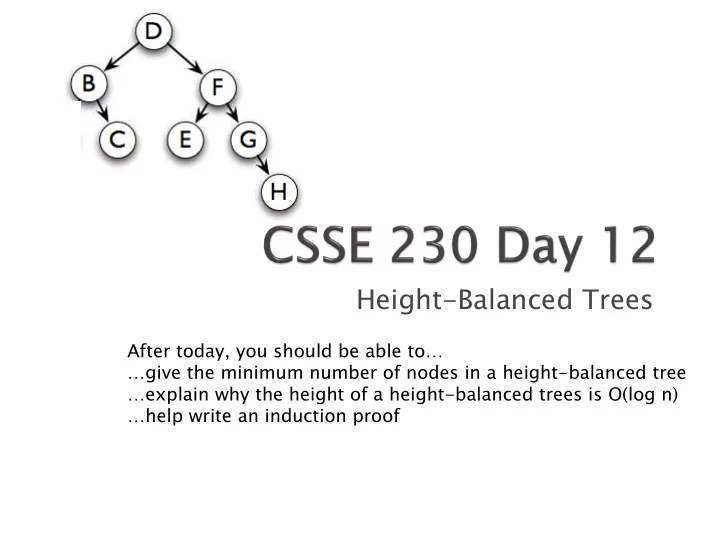

Height-Balanced Trees After today, you should be able to… …give the minimum number of nodes in a height-balanced tree …explain why the height of a height-balanced trees is O(log n) …help write an induction proof
Can voice preferences for partners for the term project (groups of 3, starting Thursday) ◦ EditorTrees partner preference survey on Moodle Preferences balanced with experience level + work ethic If course grades close, I’ll honor mutual prefs. If no mutual pref, best to list several potential members. If you don’t want to work with someone, I’ll honor that. But if your homework or exam average is low, I will put you with others in a similar position. Sorry if that’s not your preference, but I can’t burden someone who is doing well with someone who isn’t. Consider asking potential partners these things: Are you aiming to get an A, or is less OK? Do you like to get it done early or to procrastinate? Do you prefer to work daytime, evening, late night? How many late days do you have left? Do you normally get a lot of help on the homework? ◦ If you don’t reply by tomorrow at 5:00 pm, no problem; I’ll just assign you.
Announcements ◦ Final exam: Weds, 11/18, 8:00 am. If you have a conflict, let me know by Friday. ◦ EditorTrees partner preference survey on Moodle ◦ HW5 “late day” is extended until Friday of Fall break Another induction example Recap: The need for balanced trees Analysis of worst case for height-balanced (AVL) trees
Q1 Q1 Recall our definition of the Fibonacci numbers: ◦ F 0 = 0, F 1 = 1, F n+2 = F n+1 + F n An exercise from the textbook Recall: How to show that property P(n) is true for all n≥n 0 : (1) Show the base case(s) directly (2) Show that if P(j) is true for all j with n 0 ≤j<k, then P(k) is true also Detai ails s of s step 2: a. Write down the induction assumption for this specific problem b. Write down what you need to show c. Show it, using the induction assumption
Q2 Q2 BST algorithms are O(h(T)) Minimum value of h(T) is Can we rearrange the tree after an insertion to guarantee that h(T) is always minimized?
Q3 Q3 Height of the tree can vary from log N to N Where would J go in this tree? What if we keep the tree perfectly balanced? ◦ so height is always proportional to log N What does it take to balance that tree? Keeping completely balanced is too expensive: ◦ O(N) to rebalance after insertion or deletion rebalance Solution: Height Balanced Trees (less is more)
Q4 Q4 Still height-balanced? More precisely , a binary tree T is height balanced if T is empty, or if | h hei eight ght( ( T L ) ) - hei eight ght( ( T R ) | 1, and T L L and T R are both height balanced.
Q5 Q5 Is it taller than a completely balanced tree? ◦ Consider the dual concept: find the minimum number of nodes for height h. A binary search tree T is height balanced if T is empty, or if | height( ht( T L ) ) - height ght( T R ) | | 1, and T L L and T R are both height balanced.
Q 6 6-7 Named for authors of original paper, Adelson-Velskii and Landis (1962). Max. height of an AVL tree with N nodes is: H < 1. H < 1.44 log (N g (N+2) ) – 1.328 = O(log g N)
Q8 Q8 Why? Worst cases for BST operations are O(h(T h(T)) )) ◦ find, insert, and delete h(T) can vary from O(log g N) to O(N) Height of a height-balanced tree is O(log g N) N) So if we can rebalance after insert or delete in O(log g N) N), then all operations are O(log g N) N)
Recommend
More recommend